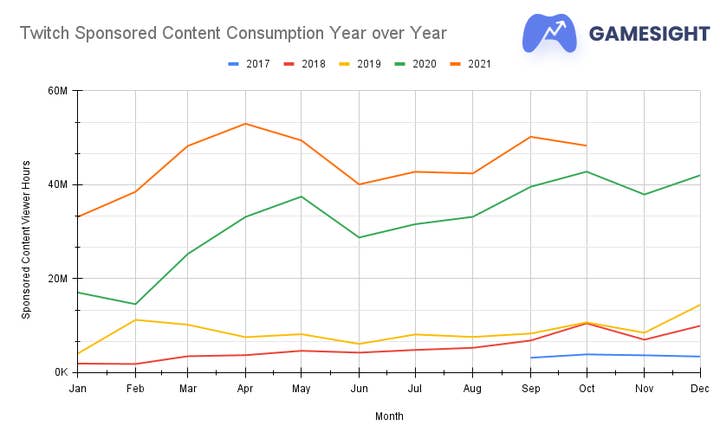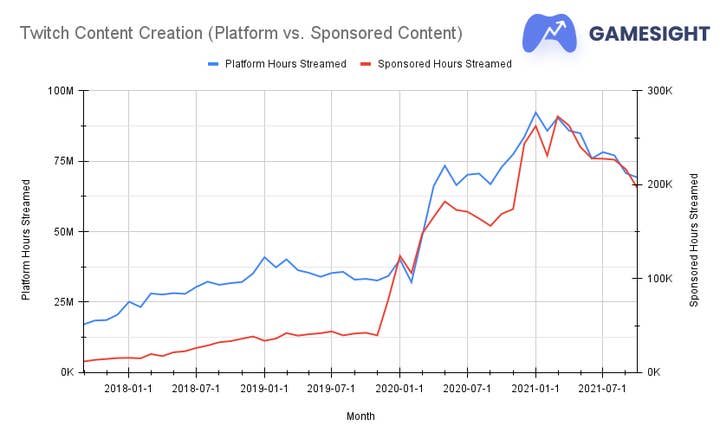How the pandemic transformed the role of sponsored content, possibly forever
Gamesight's Adam Lieb analyses the evolution of video game-related sponsored content, and marketing budgets' shift to digital in the absence of events
COVID-19 has changed the way we work and live in a myriad of ways.
While the repercussions on work structure, among others, have been well documented, with the emergence of various hybrid remote/office working models, there are consequences of the pandemic that have been less discussed as far as the games industry goes.
One such change is how it impacted the way we watch content, and subsequently how games companies and content creators have tweaked their approach in the way sponsored content is made.
Sponsored content viewership on Twitch has been consistently increasing year-on-year, games marketing platform Gamesight's CEO Adam Lieb tells GamesIndustry.biz. It grew 63.6% between 2018 and 2019, with viewership more than doubling (265.7%) between 2019 to 2021. Things didn't slow down in 2021 either, with sponsored viewership increasing a further 47.1% from January to October 2020 compared to the same period the previous year.
"There's been a total explosion in growth of content creators, content creation and viewership"
"Everything has exploded -- unsurprisingly -- since COVID. Since February of [2020], there's just been a total explosion in growth of content creators, content creation and viewership," Lieb says. "Every single metric you could possibly look at across multiple platforms, not just Twitch, are all up. Maybe that's obvious at this point: people are at home more, people have more time, they spend more time playing video games, watching video games but, interestingly it does seem that creators on Twitch disproportionately won mindshare during COVID.
"That's something that was somewhat surprising to me, which is just how many more eyeballs have been on content and then, maybe less surprising but also interesting, is the number of content creators, the number of people who sit down and turn on Twitch and decide to stream their game; that number has gone way up. All of those have really grown."

Content sponsored by games companies has not only gone up, but its effectiveness is also higher than pre-pandemic levels, Lieb continues.
"Typically, someone plays game A, [and] they're sponsored to play game B. Usually, there's some viewership drop off for game B. Audiences tune in to watch streamer [play] game A and when they're playing game B, they may not know what it is, they may not care. So that drop off, the delta between a streamer's average viewership and their sponsored stream viewership is a really important number to look at when you're trying to figure out: did this actually get the audience to tune in and care about it?
"Because ultimately what you're paying for are these audiences, and those metrics have been significantly better since COVID has started. The ultimate question is: is it a bubble? Or is it trend?"
Lieb says it's more likely to be a longer term trend, one reason being that the effectiveness of sponsored content is a hard metric to fake.
"If you just look at sponsored content creation -- the number of content creators that are streaming sponsored content -- that going up could just be a sign of a bubble, right? People investing money, game companies spending money, more content, maybe it works, maybe it doesn't. Most of our data suggests that, actually, that content has been more effective. And I think there are a few reasons for that.

"First, content creators are getting better at making sponsored content. We are seeing less cringy, totally out of brand, out of character sponsored content [so] it's more effective. Brands are [also] getting better at how they work with content creators. The first time, many companies come in and do something gross and cringy, and it doesn't work. They do things like, 'hey, let's write a script and have it read on stream' and that's terrible. That's never going to work. And it's not even getting you the influence you're hoping it's going to get you.
"And then data is the other big thing. We see data used to make determinations about who you work with, data being used to determine whether it's successful, data to determine whether you renew deals, find new partners -- just ultimately data and ROI [return on investment] are things that are going to turn something from an experimental marketing tactic to a long-term evergreen piece of how you think about building and launching products.
"I would still say there's a great mix of art and science that goes into successful sponsored content. Five years ago, I would have said it was purely art, and now there's more science mixed in. So all that would lead me to believe that it's at least likely to be a sustainable trend in the core."
On the edges of that trend are the "very non-endemic companies," Lieb explains -- firms outside of the games industry that only look at whether a streamer's demographic matches their own and goes ahead with sponsorship deals without looking for a real match.
"When you look at one of those activations, they probably spent $250,000 to do this and they've got 5,000 people who watched their piece of content, that's a real bad investment," Lieb says. "They're not really investing with content creators and sponsored content and the video game market in any long-term way. So I could definitely see that stuff falling away. But most sponsored content is still gaming related and that works, and it's working better over the last two years [compared to the previous two]."

Games companies dedicating more of their budget to sponsored content could partly be due to the absence of physical events, though Lieb points out that these budgets don't typically "come from the same pocket."
"The way marketing budgets get split, I would say they're not really competing for the same budget," he says. "What's interesting though is I think COVID changed that."
The pandemic incited games companies to think more about how to spend their marketing budget, he continues, and what falls into the marketing bracket.
"COVID has actually helped bring some of that into focus and things that you maybe looked at as PR [are now marketing]. What is going to PAX? Is that marketing? Is it PR? Is the point of going to PAX really just to get the press to talk about your game or is it to have boots on the ground and try to convince 200,000 people who walk by your booth to play your game?
"I'm sure different companies think about it differently. But I know that budgets have shifted digitally. In almost every industry over the last 25 years, digital outperforms physical for a variety of reasons.
"Whether [digital marketing] is more effective or not, you can at least prove [it], and I do think that's a big challenge with trade shows"
"It's more competitive, it's more measurable. So whether it's more effective or not, you can at least prove [it], and I do think that's a big challenge with trade shows. How do I know that a trade show is worth it, right? IGN wrote about my game, what is that worth? It's definitely worth something, is that worth the $300,000 we spent to fly half a team to San Francisco?"
Lieb adds that these are questions most companies didn't ask themselves three years ago as trade shows were just considered the standard way to market and launch a game; a status quo that is now being questioned.
"Whether they should or not is going to be an individual thing -- like everything in a competitive market, there will be some companies that go deep on in-person events and have a ton of success. Those ones will keep doing it.
"When you look more indie and you look more global, it's certainly easier now, more than ever, to make a build and launch of game for a million different reasons, and if trade shows felt like gatekeeping events -- which I think for some it did -- it has been proven in the last several years that you don't need to do that to launch a successful game of any size. So now at the end of the day they do somewhat compete for the same budget."
Lieb says 2022 is going to be a "cool A/B test" as events start re-emerging, with the effectiveness of digital marketing vs trade shows being more on display.
"We are at a tipping point. Paying people to play your game and that [being] unethical because you're somehow breaking some theoretical journalistic integrity that a streamer has -- frankly a lot of publishers had that belief, maybe eight years ago. Now I think it's basically completely gone.
"We are now to the point where I would almost never talk with a [team] that is thinking about a game launch and doesn't have sponsored content as a piece of their marketing. In the [same] way that ten years ago, no one had Facebook ads as part of their marketing budget and now, again, there's not a game that doesn't; sponsored content has moved into that realm.
"How big a piece of that pie it takes up I think is very, very fluid right now. But it is part of that marketing budget pie for probably every game I see launch with any somewhat substantial marketing budget, and then there's even those, the apexes of the world, where that just is the marketing plan -- working with content creators. That's rare but that definitely happens. That for sure is a trend that I think post-pandemic is not going anywhere."









